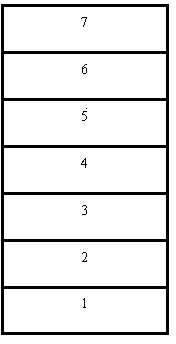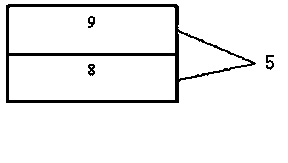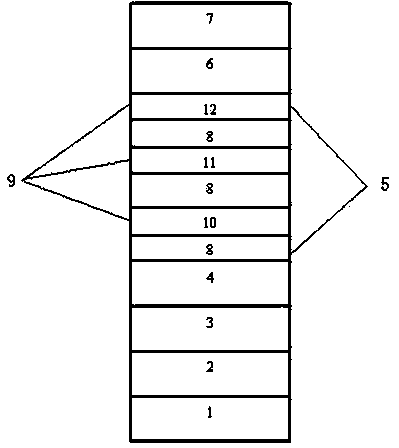Blue-light LED (Light-Emitting Diode) epitaxial structure having asymmetrical barrier layer
An epitaxial structure, asymmetric technology, applied in electrical components, circuits, semiconductor devices, etc., can solve the problems of limiting the effective recombination probability of holes, large lattice mismatch, strong built-in electric field, etc., to suppress the phenomenon of electron overflow , the effect of improving internal quantum efficiency and improving crystal quality
- Summary
- Abstract
- Description
- Claims
- Application Information
AI Technical Summary
Problems solved by technology
Method used
Image
Examples
preparation example Construction
[0023] The preparation method of the epitaxial structure is to carry out high-temperature baking in the MOCVD reaction furnace to remove the residual impurities on the surface of the sapphire substrate 1, grow a layer of AlN buffer layer 2 after slowly cooling down at 500-900°C, and then rapidly raise the temperature, The U-shaped GaN layer 3 is grown at 900-1200° C. for about 10-80 minutes, with a thickness of 1-10 um. Afterwards, the N-type GaN layer 4 is grown at a growth temperature of 900-1200° C. and a growth thickness of 1-10 um. The active region 5 is grown, and P-AlGaN 6 is grown at 800-1000° C. to a thickness of 50-1000 Angstroms. Re-grow P-GaN 7 , the growth temperature is 800-1200°C, the thickness is 1000-5000 angstroms, and the concentration of Mg is 5x10 17 ~1x10 23 cm3.
[0024] The specific growth method of the active region of the present invention includes the following steps:
Embodiment 1
[0026]The active region 5 is grown for 3 cycles in nitrogen, hydrogen or a hydrogen-nitrogen mixed environment. The active region 5 includes three parts, and each part is grown for 1 cycle. The barrier layer consists of an AlxGa1-xN layer 10, an AlyIn1-yN layer 11 Composed of InzGa1-zN layers 12, the first part of the active region 5 is the alternate growth of well layers 8 and AlxGa1-xN layers 10; the second part of the active region 5 is the alternate growth of well layers 8 and AlyIn1-yN layers 11; the active region 5 The third part is the alternate growth of well layer 8 and InzGa1-zN layer 12. The growth temperature of the first part of the AlxGa1-xN layer 10 is 650 ° C, the Al composition is 017 cm 3 ; The growth temperature of the second part of the AlyIn1-yN layer 11 is 650°C, the Al composition is 017 cm 3 In the third part, the growth temperature of the InzGa1-zN layer 12 is 650°C, the In composition is 017 cm 3 .
Embodiment 2
[0028] The active region 5 is grown for 6 cycles in a nitrogen, hydrogen or hydrogen-nitrogen mixed environment. The active region 5 includes three parts, and each part is grown for 2 cycles. The barrier layer consists of an AlxGa1-xN layer 10, an AlyIn1-yN layer 11 Composed of InzGa1-zN layers 12, the first part of the active region 5 is the alternate growth of well layers 8 and AlxGa1-xN layers 10; the second part of the active region 5 is the alternate growth of well layers 8 and AlyIn1-yN layers 11; the active region 5 The third part is the alternate growth of well layer 8 and InzGa1-zN layer 12. The growth temperature of the first part of the AlxGa1-xN layer 10 is 850°C, the Al composition is 018 cm 3 ; The growth temperature of the second part AlyIn1-yN layer 11 is 800°C, the Al composition is 018 cm 3 In the third part, the growth temperature of the InzGa1-zN layer 12 is 800°C, the In composition is 018 cm 3 .
PUM
| Property | Measurement | Unit |
|---|---|---|
| Growth temperature | aaaaa | aaaaa |
Abstract
Description
Claims
Application Information
 Login to View More
Login to View More - R&D
- Intellectual Property
- Life Sciences
- Materials
- Tech Scout
- Unparalleled Data Quality
- Higher Quality Content
- 60% Fewer Hallucinations
Browse by: Latest US Patents, China's latest patents, Technical Efficacy Thesaurus, Application Domain, Technology Topic, Popular Technical Reports.
© 2025 PatSnap. All rights reserved.Legal|Privacy policy|Modern Slavery Act Transparency Statement|Sitemap|About US| Contact US: help@patsnap.com



